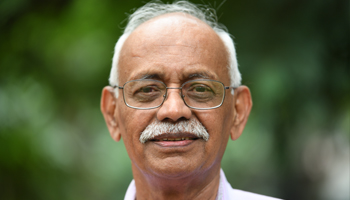

Honorary Professor
FASc, FNA, FTWAS
Ph.D. IIT Kanpur
Email: ramasesh@iisc.ac.in
Phone: +91 80 2293 2925/2336
Modeling Electronic and Magnetic Properties of Molecular and Low-Dimensional Materials
The interplay of electron–electron interactions, electron–phonon interactions and low–dimensionality has led to a wealth of truly astounding electronic, magnetic and structural instabilities. In conjugated molecules and polymers, correlated electronic structure studies hold the key to understanding strong fluorescence and large nonlinear optic responses. Our group has been developing novel techniques for many-body models employed in the study of large molecules and low-dimensional materials. Our group has extended exact diagonalization methods, developed nonperturbative methods such as density matrix renormalization group (DMRG) methods and quantum Monte Carlo (QMC) methods to study large systems. We have also extended the many-body techniques to study real time dynamics. These techniques have been applied to study, correlated electronic structure of C60 and its fragments, exciton binding energy in conjugated polymers, relative ordering of one and two-photon states, effects of quantum confinement, dynamics of electron-hole recombination and triplet-triplet scattering. In spin systems, we have studied the quantum phases of dimerized and frustrated spin chains, spin excitations and low-temperature properties of alternating spin systems and spin ladders, low energy excitations and quantum hysteresis in large spin clusters. Recently we have developed a model for understanding photomagnetism in the CuMo6 inorganic complex. We have modeled superexchange interactions in A-B systems and have explained how, contrary to Goodenough-Kanamori rules; the sign of exchange can switch from ferromagnetic to antiferromagnetic depending upon system size, geometry and chemical environment. For single molecule magnets we have recently developed models for predicting magnetic anisotropy constants in systems with many spin centers.
- “Fully symmetrized valence-bond based technique for solving exchange Hamiltonians of molecular magnets”, Sahoo S, Rajamani R, Ramasesha S., Diptiman Sen, Phys. Rev. B, (2008) 78, 054408.
- “Theoretical approach for computing magnetic anisotropy in single molecule magnets”, Raghunathan R, Ramasesha S., Sen D, Phys. Rev. B, (2008) 78, 104408.
- “Scaling exponents in spin-1/2 Heisenberg chains with dimerization and frustration studied with the density-matrix renormalization group”, Kumar M, Ramasesha S., Sen D, Diptiman Sen, Z. G. Soos, Phys. Rev. B, (2007) 75, 052404.
- “Microscopic model for high-spin versus low-spin ground state in [Ni2M(CN)(8)](M=Mo-W-V,
Nb-IV) magnetic clusters”, Raghunathan R, Sutter JP, Ducasse L, Cedric Desplanches, Ramasesha S., Phys. Rev. B, (2006) 73, 104438. - “Microscopic model for photoinduced magnetism in the molecular complex [Mo(IV)(CN)(2)
(CN-CuL)(6)](8+) perchlorate”, Raghunathan R, Ramasesha S., Mathoniere C, Valérie Marvaud, Phys. Rev. B, (2006) 73, 045131. - “Neutral and charged excited states in polar organic films: Origin of unusual electroluminescence in tri-p-tolylamine-based hole conductors”, Mukhopadhyay S, Topham BJ, Soos ZG, Ramasesha S.,
J. Phys. Chem. A, (2008) 112, 7271. - “Tuning the bond order wave (BOW) phase of half-filled extended Hubbard models”, Manoranjan Kumar, Ramasesha S., Z. G. Soos, Phys. Rev. B, (2008) (accepted).
- “A density matrix renormalization group study of low-lying excitations of polyacene within a Pariser-Parr-Pople model”, C. Raghu; Y. Anusooya Pati; Ramasesha S., Phys. Rev. B (2002) 66, 035116.
- “Nonlinear optical properties of linear chain phosphazene (PN)X ”, P.C. Jha; Anu Krishnan;
P.K. Das; Ramasesha S., J. Chem. Phys. (2002) 117, 2873. - “Formation crosssections of singlet-triplet excitons in π-conjugated polymers”, M. Wohlgenannt; Kunj Tandon; S. Mazumdar; Ramasesha S., Z.V. Vardeny, Nature (2001) 409, 494.

